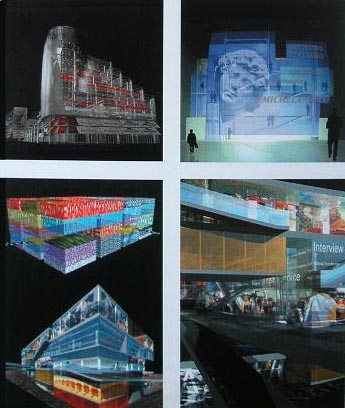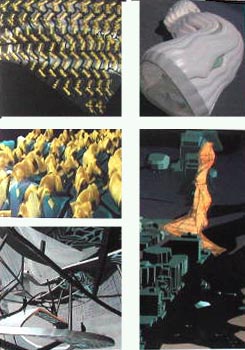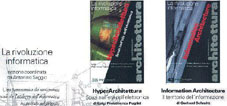Paesaggi Informatici
Prefazione di Antonino Saggio

Se è vero che l’architettura si fonda
sui suoi materiali specifici (l’articolazione degli usi, le concezioni
dello spazio, le modalità costruttive e tecnologiche, le ricerche
sul linguaggio espressivo) è altrettanto vero che si costruisce
anche attraverso l'uso di materiali "altri". Materiali apparentemente all’architettura
estranei, ma che in realtà costituiscono la spina dorsale di un
riferimento più ampio e più profondo che lega la riflessione
architettonica al mondo, alla società, alle concezioni scientifiche
e filosofiche del proprio tempo.
Ora il libro Nuovi Scapes che avete tra le mani viene
a completare all’interno di questa collana una sorta di trilogia
caratterizzata proprio dalla presenza al centro della trattazione di un
tema apparentemente eccentrico ma che ha da sempre influenzato la riflessione
dell’architettura: se Alicia Imperiale in Nuove Bidimensionalità
aveva affrontato il tema del substrato informativo e descrittivo
dell’architettura e della sua rappresentazione, e Maria Luisa Palumbo in
Nuovi ventri aveva indagato il rapporto tra uomo (e concezione dell’uomo
e del corpo) e architettura, Paola Gregory si concentra ora sulle
relazioni tra concezione di natura e di paesaggio e l’architettura.
Tutti e tre questi campi sono fecondi sia singolarmente
sia se visti nel loro insieme. E lo sono fecondi, tanto più
perché siamo nel momento di un trapasso. Il suffisso "Nuovi"
che accomuna tutti e tre i titoli, proprio questo sta ad indicare nele
opportunità che si aprono all'architettura all'interno del paradigma
informatico. Guardando insieme i tre volumi si trovano interessanti analogie,
interessanti "movimenti comuni". E’ il movimento verso la complessità,
il movimento verso la profondità concettuale che ci è dischiusa
di fronte.
"I nuovi scapes indicano all’orizzonte un nuovo modo
di vedere, progettare e abitare lo spazio, attraverso l’interpretazione
dell’opera come sistema complesso di connessioni, interscambi e retroazioni,
sempre aperto, flessibile, modificabile." Al contrario di quanto si può
in un primo momento pensare, l’accettazione consapevole del paradigma informatico
e dei suoi strumenti rende più profonde le ragioni, le influenze,
i processi.
All’aprirsi di grandi strumenti di simulazione della
complessità, che è un portato fondamentale della indagine
e della modellazione permessa dalla base matematica scientifica dell’informatica,
si collega un vettore di penetrazione nella ricchezza delle relazioni della
materia, in un continuo ipotizzare relazioni mutevoli e interrelate, in
un porre al centro il metodo delle ipotesi e delle simulazione invece che
gli assunti rigidi della teoria. La ricerca si muove così
in profondità: in una superficie che diventa carica di movimenti
intrecciati e di flussi attivi, in un corpo che e si trasforma sin
nelle sue viscere e appunto in una nuova concezione di paesaggio e di natura.
Ora, il paesaggio quale fondamentale paradigma della
creazione dell’architettura è diventato da almeno un ventennio
parola di riferimento per tutto il dibattito architettonico e Paola Gregory
a questo tema ha già dedicato un bel saggio (La dimensione paesaggistica
dell’architettura, Laterza 1998). L’uomo della civiltà post-industriale
ed elettronica può rifare i conti con la natura perché se
l’industria manifatturiera doveva dominare e sfruttare le risorse naturali,
quella delle informazioni la può valorizzare. Almeno nei paesi tecnologicamente
avanzati, questo strutturale cambio di direzione apre l’opportunità
a un "risarcimento" di portata storica. In zone spesso costruite a densità
altissime si può iniettare ora verde, natura, attrezzature per il
tempo libero. Eppure proprio per le ragioni che dicevamo il processo non
è "di superficie". Non si tratta di circoscrivere e recintare aree
verdi, da contrapporre a quelle residenziali, terziarie, direzionali come
era nella logica dell’organizzare dividendo della città industriale.
Si tratta al contrario di creare nuovi pezzi di città integrate
dove accanto a una forte presenza di natura siano presenti quell’insieme
interagente di attività tipiche della società dell’informazione.
Naturalmente anche gli strumenti cambiano. Se, lo zoning era stato
il modo per pianificare la città industriale attraverso la divisione
in zone tra loro omogenee e distinte che simulava il concetto tayloristico
di produzione industriale, la plurifunzionalità e l’integrazione
è diventata la necessità della città dell’informazione
e delle sue nuove aree anti-zoning. La natura cui questa concezione del
paesaggio guarda non è più quella floreale o liberty e neanche
quella dei maestri dell’organicismo, controcanto al mondo meccanico e industriale.
È diventata appunto una concezione di natura molto più complessa,
molto più difficile, molto più "nascosta" ed è sondata
anche dagli architetti con occhio anti romantico attraverso i formalismi
della scienza contemporanea (i frattali, il dna, gli atomi, i salti di
un universo che si espande, il rapporto tra vita e materia, la geometria
topologica, le forme animate). Insomma, attraverso le categorie della complessità
cui questo libro giustamente dedica spazio. Nascono in questo contesto
le figure dei flussi, dell’onda, dei gorghi, dei crepacci, dei cristalli
liquidi e la fluidità diventa parola chiave. Descrive il costante
mutare delle informazioni e mette l’architettura a confronto con le frontiere
di ricerca più avanzate dalla biologia all’ingegneria alle nuove
fertili aree di sovrapposizione come la morfogenesi, la bioingegneria o
la biotecnologia.
L’idea è che l’architettura dopo essersi fatta
essa stessa paesaggio o nelle stratificazioni e nei palinsesti di Eisenman,
o nel residuale urbanscape di Gehry o nelle onde della Hadid o ancora nei
movimenti scoscesi del compianto Miralles può diventare paesaggio
reattivo, complesso, animato, vivo. L'informatica dunque gioca in questo
contesto quattro caratteristiche chiave:
innanzitutto fornisce i "modelli matematici" per indagare
la complessità chimica, fisica, biologica, geologica della natura
e a partire da questi modelli di simulazione consente di strutturare relazioni
nuove in progetti che ne introitano le ragioni e le dinamiche.
In secondo luogo, l'informatica fornisce armi
decisive per la costruzione reale di progetti concepiti con queste
complesse logiche "all digital" (e finalmente non abbiamo solo parole ma
anche esempi realizzati, basti pensare allo Yokohama Terminal
dei "nati con il computer" Moussavi e Zaera-Polo).
In terzo luogo, l'informatica dota l'architettura
di sistemi reattivi capaci di simulare comportamenti della natura, nella
reazione al clima, ai flussi di uso e ultimamente anche ai comportamenti
emotivi, e offre così una nuova fase di ricerca estetica di cui
ci siamo spesso soffermati parlando delle sfide dell'Interattività.
E in quarto luogo l'informatica, o meglio l'era informatica,
fornisce anche un modello complessivamente diverso di città
e di paesaggio urbano: misto negli usi, sovrapposto nei flussi, aperto
24 ore su 24 con attività produttive ludiche sociali e residenziali
in cui si intrecciano strutturalmente "natura e artificio". Sono Paesaggi
informatici se li guardiamo con occhi aperti al mondo della tecnologia,
New scapes se pensiamo anche all'insieme di riflessioni e tensioni che
questo libro, in un viaggio che non tralascia le implicazioni filosofiche
ma anche le maniere di pensare concretamente ai principi alla base
delle nuove architetture, affronta in un viaggio che, crediamo, appassionerà.
Information Landscapes
Preface by Antonino Saggio

If it is true that architecture is based on its specific
materials (patterns of use, concepts of space, construction methods and
technologies, research into expressive language), then it is just as true
that it is also built through the use of "other" materials; materials apparently
foreign to architecture, but ones that in reality make up the backbone
of a broader and deeper reference connecting architectural considerations
to the world and society, to the scientific and philosophical concepts
of their own time.
The book you hold in your hands, Newscapes, completes
a sort of trilogy in this series, one characterized precisely by the central
presence of a theme that, though apparently eccentric, has always influenced
architectural thought. Alicia Imperiale in New Flatness dealt with the
idea of the informational and descriptive substrata of architecture and
its representation, and Maria Luisa Palumbo in New Wombs investigated the
relationship between man (and the concept of man and body) and architecture,
and now Paola Gregory will concentrate on the relationship between architecture
and concepts of nature and landscape.
All three of these fields are fertile both individually
as well as seen as a whole. They are even more fertile since we are now
at a moment of passage. The prefix "New", that all three titles have in
common, indicates specifically those opportunities that have opened up
for architecture within the IT paradigm. Interesting analogies can be found
by looking at all three volumes together, interesting "common movements".
The movement toward complexity, toward the conceptual depth that has opened
up before us and is revealed in the subtitle Territory of Complexity. "The
new scapes indicate a new way on the horizon of seeing, designing and inhabiting
space through the interpretation of the work as a complex system of connections,
interchanges and retro-actions, constantly open, flexible and modifiable."
Contrary to what one might think at first, the conscious acceptance of
the IT paradigm and its tools makes reasons, influences and processes more
profound.
Along with helping create great tools for simulating
complexity, a fundamental outcome of the research and modeling allowed
by the scientific and mathematical basis of information technology, a vector
is also connected that penetrates into the richness of relations with the
material, in a continuous hypothesizing of changing and interrelated relationships,
in giving center place to the method of hypotheses and simulation instead
of rigid theoretical assumptions. And so research goes deep: into a surface
that becomes loaded with interwoven movements and active flows, into a
body that is transformed to its core, and even into a new concept of landscape
and nature.
Landscape as a fundamental paradigm in the creation
of architecture has, for at least twenty years or so, been a reference
word for the entire architectural debate. Paola Gregory has already dedicated
a book to this theme (La dimensione paesaggistica dell’architettura, [The
Landscape Dimension of Architecture] Laterza, Bari 1998). Human beings
from the electronic and post-industrial civilization can re-settle their
account with nature because if the manufacturing industry dominated and
exploited natural resources, then the information technology industry can
help increase their appreciation and conservation. At least in technologically
advanced countries, this structural change of direction opens up the opportunity
for a "compensation" of historic proportions. Green areas, nature, structures
for leisure time activities can all now be placed in areas built up frequently
with very high density construction. In other words, precisely because
of those reasons we have already mentioned, the process is not "on the
surface". We are not dealing with circumscribing and fencing off green
areas to contrast with those other residential, tertiary and managerial
areas as was part of the logic of organizing by dividing the industrial
city. On the contrary, we mean creating new integrated parts of the city
where that interacting group of activities typical of the information society
exist alongside a powerful presence of nature. Naturally, the tools change
as well. If zoning was the method for planning the industrial city through
the division into homogeneous zones that were distinct among themselves
and simulated the Tayloristic concept of industrial production, then multi-functionality
and integration have now become the necessities for the information city
and its new anti-zoning areas. The nature intended in this concept of landscape
is no longer floral or "liberty-style"; neither is it the nature of the
masters of organicism, counterpoint to the mechanical and industrial world.
This concept of nature has in fact become much more complex, much more
difficult, much more "hidden" and is also investigated by architects with
an anti-romantic eye through the formalisms of contemporary science (fractals,
DNA, atoms, the leaps of an expanding universe, the relationship between
life and matter, topological geometry, animated forms). In other words,
through the categories of complexity to which this book rightly dedicates
space. Hidden in this context are the figures of flows, the wave, whirlpools,
crevasses and liquid crystals; fluidity becomes the key word. It describes
the constant mutation of information and places architecture face to face
with the most advanced research frontiers, from biology to engineering,
to the new fertile areas of superimposition such as morphogenisis, bioengineering
or biotechnology.
The idea is that architecture, after having made itself
into landscape, whether in the stratifications and palimpsests of Eisenman,
or the residual urbanscape of Gehry, or the waves of Hadid or again in
the precipitous movements of the late Miralles, can become a reactive landscape,
complex, animated and alive. Thus Information Technology plays three key
roles in this context:
First of all, it supplies the "mathematical models"
to investigate the geological, biological, physical and chemical complexity
of nature and, beginning with these models of simulation, allows the structuring
of new relations in projects that exploit reasons and dynamics.
In the second place, IT supplies decisive weapons for
the real construction of projects conceived with this complex "all digital"
logic, (and finally we not only have words but real examples as well, just
consider the Yokohama Terminal by those two architects "Born with the Computer",
Moussavi and Zaera-Polo);
In the third place, IT endows architecture with reactive
systems capable of simulating types of behavior in nature, in reacting
to climate, usage flows and ultimately also emotional behavior, and so
offers a new phase of esthetic research we have frequently discussed when
speaking of the challenges of Interactivity.
And in the fourth place, IT, or rather the Information
Age, also supplies an overall different model of the city and urban landscape:
mixed in its uses, superimposed in its flows, open 24 hours a day, with
"nature and artifice" structurally interwoven into production, leisure,
social and residential activities. These are Information Landscapes if
we look at them with eyes open to the world of technology, New Scapes if
we also consider the group of considerations and comparisons that this
book confronts in a voyage that neglects neither philosophical implications
nor the methods of concretely considering the basic principals of this
new architecture, and one that we feel is very exciting.




